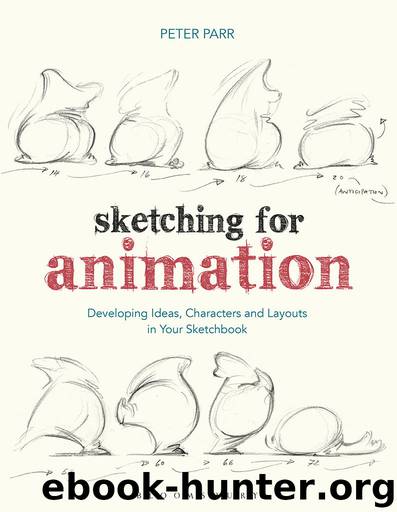Sketching for Animation: Developing Ideas, Characters and Layouts in Your Sketchbook (Required Reading Range) by Peter Parr

Author:Peter Parr [Parr, Peter]
Language: eng
Format: azw3
ISBN: 9781350033917
Publisher: Bloomsbury Publishing
Published: 2017-07-06T04:00:00+00:00
4.56 a–b Your subject should affect your choice of drawing instrument. In Figure 4.56 a, I used a quill pen to scratch, pluck and spatter out inky marks and watercolour to give richness to this drawing of the fallen oak tree. In Figure 4.56 b, the same tree is drawn with a brush pen and coloured pencils. Different materials send out different messages.
MARK MAKING TO EVOKE AN EMOTIONAL RESPONSE
An acknowledgement and engagement with texture enriches your knowledge of surfaces: an important asset for the background artist. Your choice of materials and techniques cannot be over-estimated when searching to create a mood or an atmosphere. Animator Michael Dudok de Wit made this study to illustrate the charcoal drawing technique he used in his Academy-Award winning film, Father and Daughter. His drawing, produced during his lecture, was not drawn from nature, though looking at the sensitivity of the image, I suspect its feeling is informed by close observation.
Writer, animator and director Michael Dudok de Wit: ‘I would draw on smooth paper with charcoal and sometimes, for the small details, with a 3B pencil as well. The charcoal was mostly applied with my fingertips and the palm of my hand. The hand needed to be washed frequently with soap to keep it very clean and dry. The backgrounds had a simple graphic style and working with charcoal was incredibly fast; I could therefore easily make many attempts before arriving at the right image. Sometimes I would draw the complete background on one sheet, while other times I would create the sky on one sheet and the landscape on another.’
‘After scanning the drawing I would modify it with Photoshop and a graphic pad to enhance the contrast, to paint the grey tones with a sepia colour, to remove small imperfections, especially in the skies, and to alter some details if necessary. Drawings that were made on two separate sheets would of course be combined with Photoshop into one complete background.’
‘I chose sepia over grey for several reasons. I hoped that the brown colours would look beautiful and that they would also enhance the nostalgic quality of the film. Because the design of the main character, the woman, changes dramatically throughout the story, it was important for the clarity of the story to give her a recognizable feature that she would keep from the start until the end. I chose to give her the only non-brown colour in the film, a greyish blue, a colour that combines particularly well with the browns.’
Download
This site does not store any files on its server. We only index and link to content provided by other sites. Please contact the content providers to delete copyright contents if any and email us, we'll remove relevant links or contents immediately.
Call Me by Your Name by André Aciman(18964)
Ready Player One by Cline Ernest(12837)
How to Be a Bawse: A Guide to Conquering Life by Lilly Singh(6693)
Wiseguy by Nicholas Pileggi(4586)
The Kite Runner by Khaled Hosseini(4431)
On Writing A Memoir of the Craft by Stephen King(4213)
The Crown by Robert Lacey(4105)
Audition by Ryu Murakami(4098)
Call me by your name by Andre Aciman(4072)
Harry Potter and the Cursed Child: The Journey by Harry Potter Theatrical Productions(3962)
Gerald's Game by Stephen King(3918)
The Perils of Being Moderately Famous by Soha Ali Khan(3782)
Dialogue by Robert McKee(3582)
Dynamic Alignment Through Imagery by Eric Franklin(3488)
Apollo 8 by Jeffrey Kluger(3199)
How to be Champion: My Autobiography by Sarah Millican(3185)
Seriously... I'm Kidding by Ellen DeGeneres(3100)
Darker by E L James(3087)
History of Dance, 2E by Gayle Kassing(3000)
